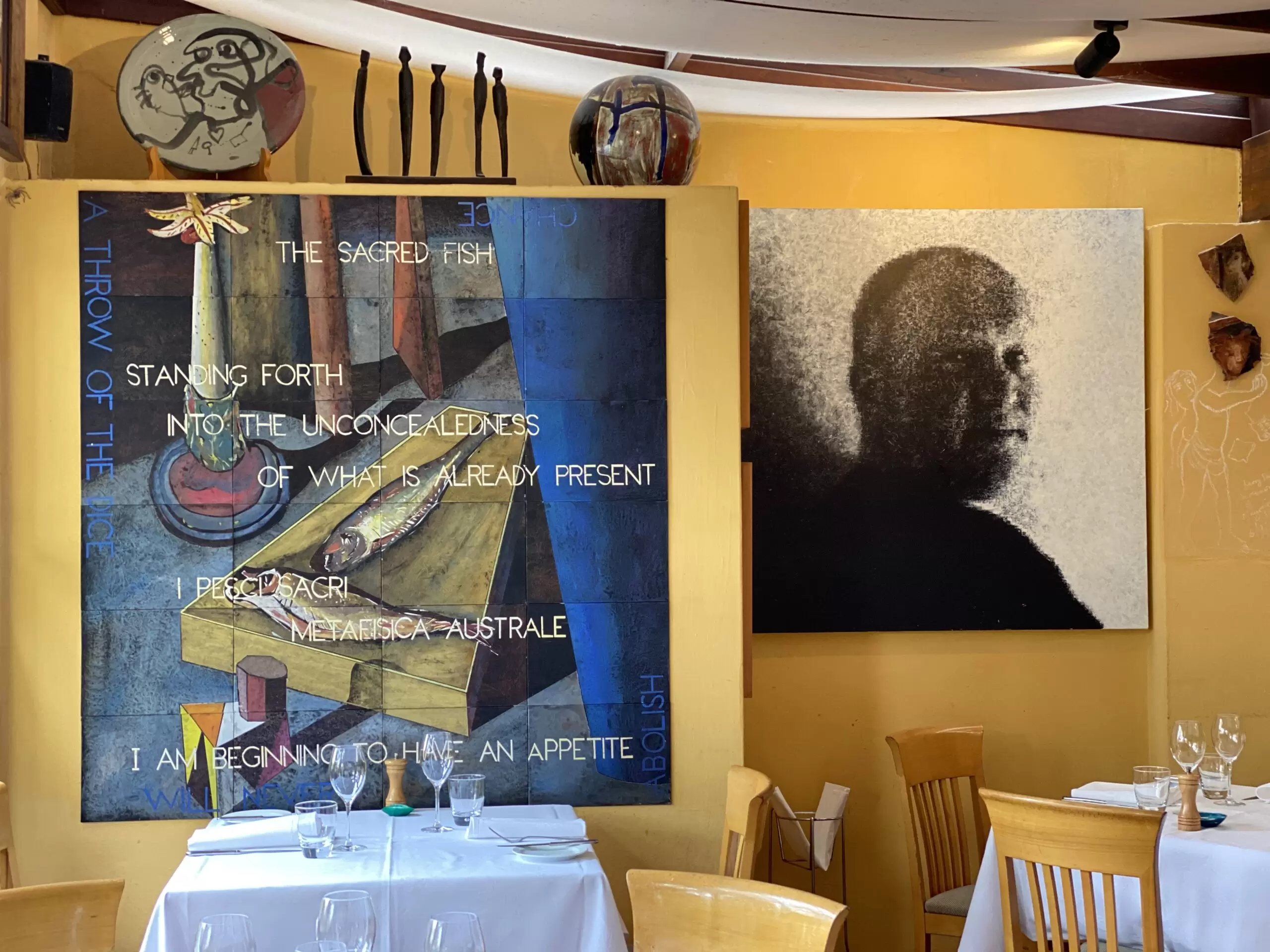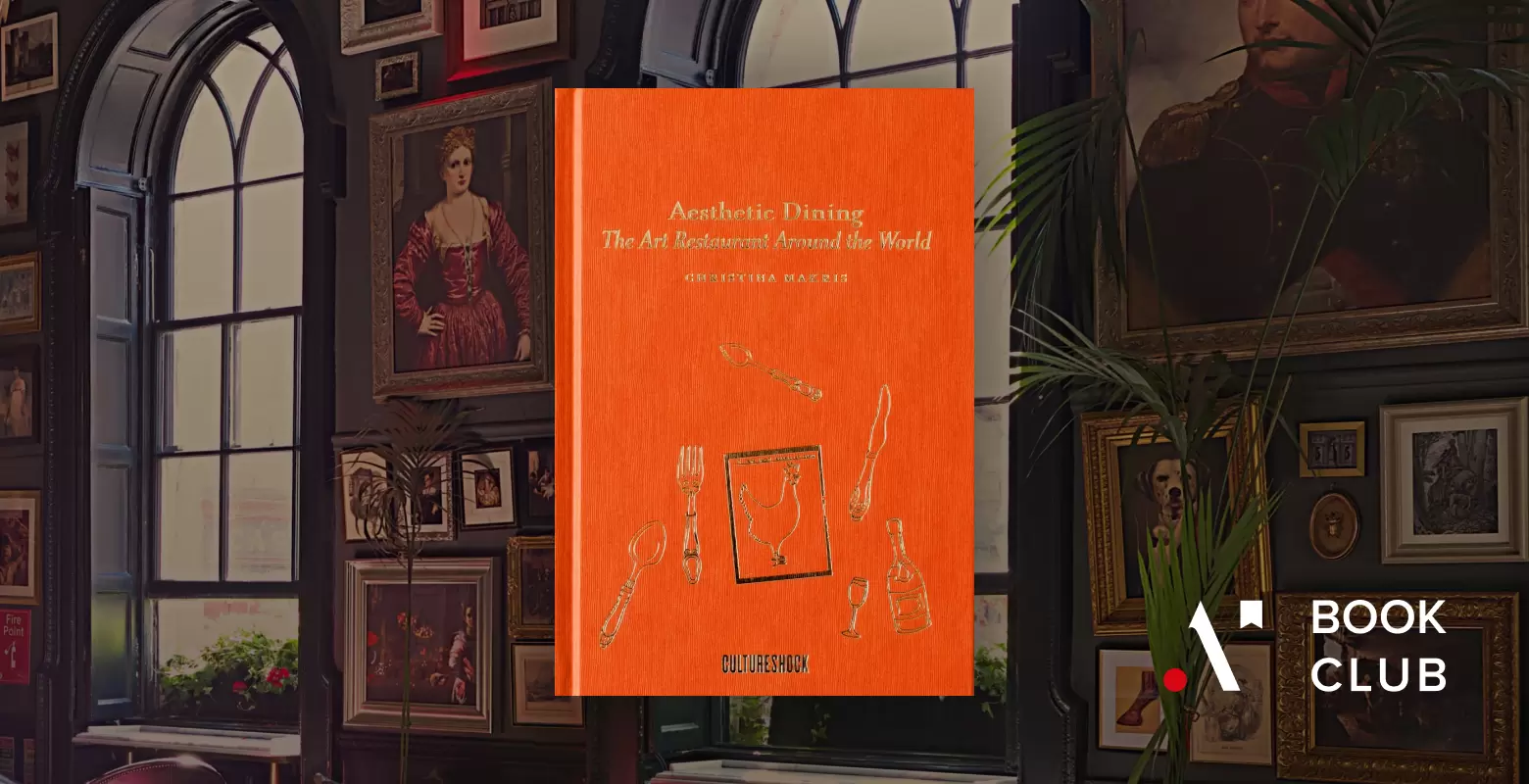From Table to Tableau: The Art Restaurant by Christina Makris
To accompany this month's book club and in case you can't assist with our upcoming Instagram Live, we thought of asking Christina Makris to talk to us more about her experience and book. Here is what she had to say. Don't miss us on Instagram on May 31st at Noon EST | 5 pm BST for a lively conversation about art, food, wine and restaurants!


The fusion of food and art has become increasingly pronounced in contemporary culture. Art lovers are also food lovers, museums pay attention to what they serve in their venues, chefs adopt creative processes, artists are inspired by culinary processes, and both collaborate on immersive dining experiences. The art world is “the most social of the worlds,” according to British artist Michael Craig-Martin, and the tradition of the gallery dinner is just as much a part of an artist’s evolution into the market as the partnership with the right gallerist and solo show is.
An accompanying dish on this table setting of art and food is the art restaurant, a restaurant that explores various relationships with art, either by displaying an art collection, commissioning artists to make works for the space, or being run by chefs or restaurateurs who invite artists to participate in the dining experience. As I explore in my book, Aesthetic Dining, these art restaurants exist around the world, and models range from the organic accident to the designed collaboration. There is an undeniable affinity between artists and chefs. They just can’t leave each other alone, and they often celebrate these relationships in art restaurants. Such restaurants which invite art into the dining environment have been in existence for over a century; as early as the 18th Century when del Cambo restaurant in Turin commissioned the finest artisans to guild and fresco its interiors; to the late 19th Century when Maxim’s in Paris deployed the leading art nouveau artists to create opulent interiors to reflect decadent tastes of its patrons.

Art restaurants have been important backdrops to moments of cultural history, playing a part in the chance and fate of artistic moments and historic events. For instance, Dooky Chase restaurant in New Orleans has been serving Southern comfort food since 1939, with chef Leah Chase at its helm making her famous gumbo dishes (adored by the Bushes and Obamas) in her signature pink apron. In the 1960s and 1970s, the restaurant was a meeting place for key figures of the Civil Rights movement to plan campaigns and hold rallies. Around the same time, Leah Chase fell in love with art when a friend took her to New Orleans Museum of Art to listen to Harlem Renaissance artist Jacob Lawrence give a lecture. They became fast friends as they were both alumni of the WPA programme and it occurred to Chase that her restaurant could become “another layer of community support.” She began inviting artists of mixed ages, career levels, and training to hang works on her walls. She took care of the food and they “the finest artists and all they had for me to learn from,” reciprocated in art. Works in the restaurant collection include some of the most important African American artists of the 20th century, such as Elizabeth Catlett, John T. Biggers, and Melvin Edwards. Chase passed away in 2019 at age 94, but she lives on as an American folk hero, her portrait by Gustave Blanche hangs in the Smithsonian, Disney based its Princess and the Frog on a young Leah, and there are memorials, murals and stories devoted to her generosity strewn all around the city.

Incorporating artworks into a restaurant is a signal of something more refined and symbolic in terms of taste. Art collections displayed in restaurants might be a sign that the restaurateur thinks differently that they understand the totality of the dining experience and that also see the restaurant as a space for the enjoyment of art for wider audiences. There is a famous Rolling Stone photo of an inebriated Iggy Pop falling out into a snow-covered Berlin Street in 1979, after an interview with David Bowie. The restaurant behind him is the Paris Bar in the Charlottenburg district, a seemingly traditional French brasserie on one level, serving onion soup and Croque monsieur. However, on another level the venue has played host to countless celebrities from all creative fields—from Helmut Newton to Madonna to Yves Saint Laurent to Jack Nicholson—this rock and roll ethos also extended to an artistic level as this was the restaurant German artist Martin Kippenberger used to hold court throughout the 1980s and early 1990s and orchestrate his frenzied parties, dinners, and gatherings for artists. Kippenberger had an arrangement with proprietor Michel Würthle, allowing him to keep a perpetual open tab in exchange for artworks. The artist would perform his outré antics every night, attracting other contemporaries such as Sigmund Poke and Robert Rauschenberg, as well as new generation artists who were visiting Berlin on the German Academic Exchange Service, including Damien Hirst and Sarah Lucas. The restaurant became an alternative gallery space for Kippenberger, and he would use it as a studio space to make drawings and sketches, hold festivals, and showcase artists he thought needed more recognition such as Louise Lawler, Barbara Ess and Laurie Simmons. This restaurant’s collection is informed by the same spirit of rebellion and irreverence as befits Berlin’s counterculture of that time.
The art restaurant can also be a place for artists to induct other artists in the tradition of an artist’s restaurant and its sense of community. One December evening in 1984, Australian artist Sidney Nolan stopped in a quiet corner Italian trattoria in the Paddington district of Sydney. Very pleased with his meal he drew one of his iconic square-headed Ned Kelly figures on a ticket docket as a thank you to the proprietor, Lucio Galletto. This ignited a passion for collecting in the chef who always regarded his cooking as a creative process – “I grew up in the family restaurant learning the saying ‘the eye wants its share.’ When we prepare a dish, we think about the experience of the dish.” Galletto soon amassed a collection of over 200 works of some of the most well-regarded 20th Century Australian artists, including John Olsen, Charles Blackman, Tim Storrier, and John Beard, as well as newer generation artists such as Ben Quilty who were initiated into the Lucio’s tradition of long artists lunches, salons and debates. The art-filled walls are a compendium of the artist’s gratitude to the sense of community the restaurant built and as artist Luke Sciberras says, “Lucio’s is culture in crucible form.”

The artworks in art restaurants exist outside the white cube space and the gallery system. They instead let diners examine what it is like to live with art, to eat with art, drink with art, in an everyday setting. There is something more alive about artworks being placed in restaurants – Damien Hirst, who has been very involved with restaurants as an artist and entrepreneur throughout his career, says “a restaurant is a living thing, the furthest away from the gallery you could get, which [is] merely a room for dead people if you [aren’t] careful.” Craig-Martin says eating in the midst of artworks is “like renting a work of art for the duration of the meal, it’s yours for that period,” and is more “democratic” and inclusive than the gallery system. Art restaurants are important cultural outputs because the restaurateur shares their taste with their diners and designs the space to include these gestures of aesthetic sensibility, whether diners are fully aware of it or not when they dine, and whether or not diners have a background in art. And if the artists’ involvement and continuous fascination with restaurants and food is anything to go by, art restaurants should even be considered artworks in their own right.
How to link your .ART domain to your Instagram account Read More How .ART Domains Are Taking Artists Online Read More How to register a business email on .ART Read More
More about the author Christina Makris
 In pursuit of visual taste and aesthetic dining, Christina Makris has travelled to six continents, visited more than 100 cities and sat at countless tables. She began her career in academia, and earned a doctorate in Philosophy from the University of Sussex, where she lectured and researched in phenomenology and aesthetics. Christina has been involved in the arts as a collector, a philanthropist, and patron, and involved with restaurants as an investor, consultant and sybarite. She is a Trustee of Site Gallery in the UK and she writes and lectures on art and food. And because she believes you can never be overeducated or underdressed, she has also recently completed her WESET Level 2 and Level 3 in wine education and is currently researching and writing a project on art and wine.
In pursuit of visual taste and aesthetic dining, Christina Makris has travelled to six continents, visited more than 100 cities and sat at countless tables. She began her career in academia, and earned a doctorate in Philosophy from the University of Sussex, where she lectured and researched in phenomenology and aesthetics. Christina has been involved in the arts as a collector, a philanthropist, and patron, and involved with restaurants as an investor, consultant and sybarite. She is a Trustee of Site Gallery in the UK and she writes and lectures on art and food. And because she believes you can never be overeducated or underdressed, she has also recently completed her WESET Level 2 and Level 3 in wine education and is currently researching and writing a project on art and wine.
Enter our giveaway on Instagram for your chance to win one of the 5 copies of Aesthetic Dining – The Art Restaurant Around the World will be given!

More about the Book Club here




